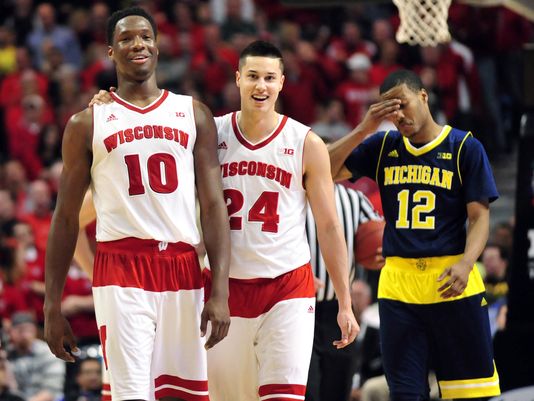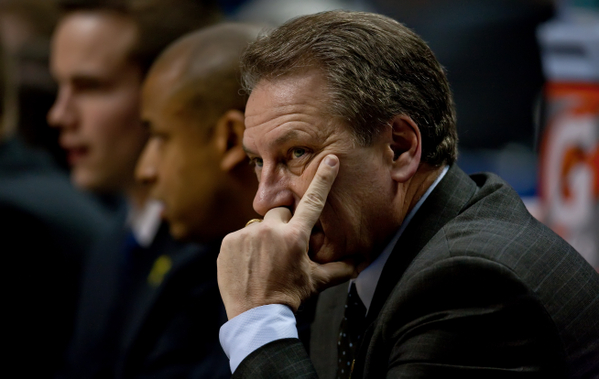Race for a Top NCAA Seed Begins Early in the Big Ten
Posted by Shane McNichol on November 29th, 2016At least one team has represented the Big Ten at the Final Four in six of the last nine NCAA Tournaments and seeding is a big part of that. Big Ten teams have been awarded a #1 seed in four of those nine tourneys with seven more conference teams receiving #2 seeds over that period. Being projected among the mix to win the conference title usually means that the jockeying for March begins right away. In the season’s first two weeks, Wisconsin, Michigan State and Indiana all had great chances to put themselves in the Big Ten pole position before conference play even begins. Yes, the NCAA Tournament is still three and a half months away, but the Selection Committee weights all games the same regardless of when they are played. Parsing through the first handful of games among this trio allows us a chance to see which, if any, teams took an early head start in the race for a top-two NCAA Tournament seed.
Michigan State
The Spartans’ early struggles have been well-documented so there’s no reason to re-hash them here. With three losses already on the books and a very difficult game at Cameron Indoor Stadium tonight, dreams of a #1 seed have been all but dashed in East Lansing. In the past 10 NCAA Tournaments, only one school has been awarded a top seed with seven or more regular season losses — Michigan State in 2012. With games at Minnesota, Ohio State, Indiana, Michigan, Purdue and Maryland still to come (not to mention several other potentially tricky road tilts as well as home games against Purdue, Michigan, Ohio State, and Wisconsin), the Spartans are very likely to surpass that loss figure. The loss of Denzel Valentine and his 28.9 percent usage rate has proven difficult to replace, as the capable role players around him last season have so far failed to step up. Instead, it has been freshmen like Miles Bridges, Joshua Langford, and Cassius Winston who have sparked the Spartans during their better moments. Tom Izzo hasn’t yet found the right combinations but history suggests that he will do so. Whether he can manage to turn things around quickly enough to push Michigan State into the discussion for a #2 seed is an open question.
Wisconsin

Nigel Hayes and Bronson Koenig are shooting a combined 26 percent on the season thus far. (USA TODAY Sports).
A win over North Carolina is exactly what Wisconsin wishes it had found in Maui last week. The Badgers were very impressive in wins over Tennessee and Georgetown but stumbled mightily in the event’s championship game. The Badgers are now 0-2 against KenPom top 25 opponents. Nigel Hayes and Bronson Koenig are shooting a combined 26 percent on the season, and it is becoming increasingly clear that sophomore Ethan Happ is Greg Gard‘s most reliable option. The good news is that Wisconsin will have many more chances to collect the signature wins that warrant a #1 or #2 seed. The Badgers welcome both Syracuse and Oklahoma to the Kohl Center this week, followed by a trip to rival Marquette on December 10. If Wisconsin drops even one of its three remaining marquee non-conference games, only a regular season Big Ten crown would keep a #1 seed in play. And even that might not be enough given the other national competitors at the top. The ACC appears likely to capture two #1 seeds (among the group of Duke, North Carolina, Louisville, and Virginia) and Villanova, Kentucky, and Kansas are all building impressive resumes as well. Even Gonzaga cannot be discounted if the Zags think about running the table. If Wisconsin is among the group in the top line conversation on Selection Sunday, it will likely be because the Badgers collected two key wins this week.
Indiana
Tom Crean‘s Hoosiers have dropped only one game to date, but that defeat at IPFW caught a lot of pre-Thanksgiving attention. For casual fans, seeing #3 Indiana lose to the Mastodons was a shocker, but the truth is that this loss shouldn’t hurt the Hoosiers too much. It will be considered a true road loss, and the Selection Committee has a longstanding tradition of encouraging high-major programs to challenge themselves with difficult games (e.g., the Hoosiers will be awarded 0.6 of a loss in the RPI, as opposed to the 1.4 losses awarded for a home loss). Scheduling an intrastate road game was a considerable and calculated risk taken by Crean, but it comes with the reward that it won’t look that damning so long as Fort Wayne (currently 121st nationally) doesn’t completely fall apart the rest of the season. A win on Wednesday night over visiting North Carolina would keep Indiana in the top seed conversation.














































